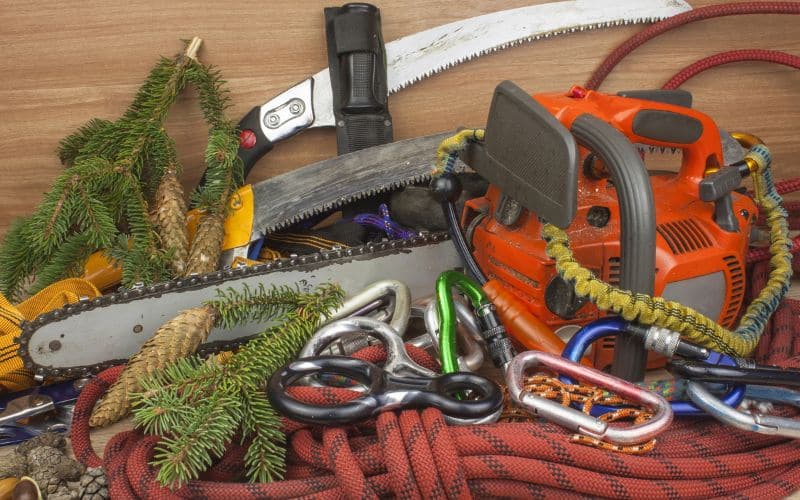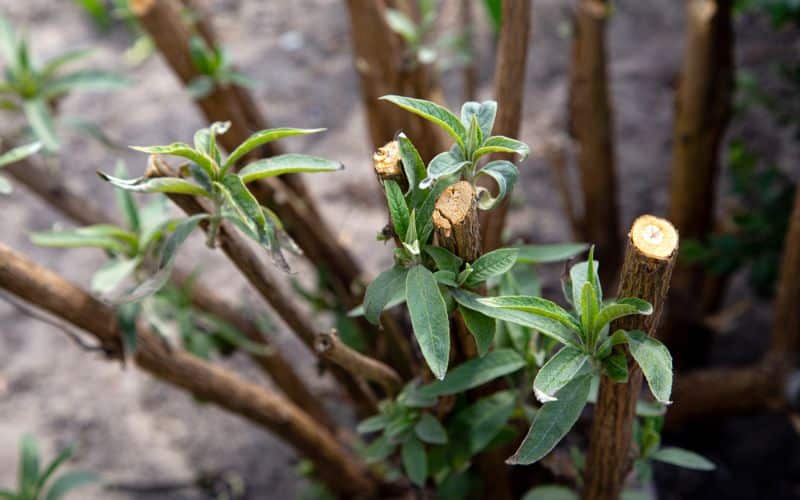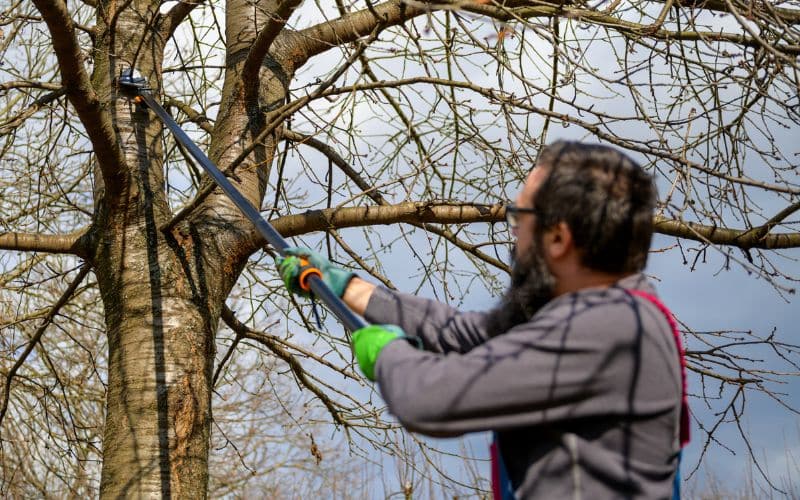
Understanding when to trim your trees is vital for maintaining their health and beauty. Just like you, each tree in your garden has its unique needs, influenced by its species and environment. To ensure you’re giving your trees the best care, timing is everything.
Fall and winter are generally the best times to trim most trees, as they’re dormant and less susceptible to harm. However, specific tree types, like Bradford pears, require a tailored approach to pruning for structural integrity. It’s about knowing the when as much as the how.
Understanding the Importance of Trimming Trees
When you’re looking to maintain the health and aesthetics of your trees, trimming should be a non-negotiable part of your garden care routine. But why exactly is it so essential? Here’s what you need to know.
Why Is Tree Trimming Necessary?
Tree Trimming Supports Plant Health
Regular pruning is critical to prevent diseases and pests from taking a hold of the tree. By removing diseased or dead limbs, you’re stopping the spread of potential infestations that could further damage or even kill the tree. It’s a bit like cutting out the bad to protect the good.
Critical for Safety
Overgrown branches can pose a hazard. Strong winds or storms might cause these limbs to fall, which could damage property or even harm individuals. Trimming these branches ensures safety for you and your property.
Aesthetic Appeal
Properly pruned trees have a commendable symmetry that naturally enhances your garden’s appearance. It’s about nurturing a shape that complements the landscape.
Prevents Overgrowth
Uncontrolled growth can lead to dense foliage that blocks sunlight and air from reaching the inner areas of the tree or other plants underneath, hampering their growth.
- Tree Health Improvement
- Enhanced Fruit Production
- Storm Damage Prevention
- Encourages New Growth
- Improved Visibility and Sunlight Penetration
- Maintains intended Landscaping Goals
When trees are trimmed correctly and at the right times, they are set on a pathway of robust growth and vigor. It’s more than just aesthetics; it’s about fostering a healthy, safe, and thriving garden ecosystem. You’ll notice that properly trimmed trees integrate seamlessly into the landscape — their natural beauty stands out without the obvious signs of human intervention.
Signs That Indicate It’s Time to Trim Your Tree
Damaged or Dead Branches
Identifying damaged or dead branches is crucial in maintaining the health and safety of your trees. Damage to branches can stem from adverse weather, disease, or pests. Dead branches may appear dry, brittle, and devoid of leaves. These branches can fall unpredictably, posing a threat to safety. You should regularly inspect your trees for these telltale signs:
- Bark that’s loose or peeling away
- Mushrooms or fungi growing on or near branches
- Branches that do not bud or leaf out
The removal of these damages ensures the tree’s vitality and protects the landscape and surrounding structures.
Overgrown or Dense Canopy
An overgrown or dense canopy prevents sunlight and air from reaching the inner parts of the tree and the landscape below. You can determine if the canopy needs thinning if you observe:
- Little to no undergrowth due to insufficient sunlight
- Dead interior branches resulting from poor air circulation
- A canopy so dense that it sways as a single unit in the wind
Thinning out the tree improves sunlight exposure and air flow, which in turn supports healthy growth patterns.
Obstructing or Interfering with Utilities
Trees that grow too close to power lines, buildings, or other structures require immediate attention. Branches that touch or hover near utilities are not just inconveniences; they’re potential hazards. Interference with utilities can result in:
- Power outages
- Damage to infrastructure
- Blocked pathways or visibility for traffic
Regular trimming keeps the tree’s growth in check, preventing costly damages and dangerous situations. Keep an eye on branches nearing utility lines and have them professionally trimmed to avoid risks of electrocution and to comply with local regulations.

Factors to Consider Before Trimming a Tree
Type of Tree
Different tree species have unique pruning requirements and react differently to trimming. Deciduous trees, those that shed their leaves annually, benefit from pruning during late fall or early winter. This timing aligns with their dormancy and minimizes sap bleeding when growth resumes in the spring. Evergreens, on the other hand, require minimal pruning. However, removing dead or diseased branches can occur at any time. Spruce and fir trees can be pruned in late winter, while pruning pine trees involves cutting back to just above lateral buds in early spring. Knowing your tree type is crucial for proper care—pruning not only shapes the tree but also affects its growth patterns and overall health.
Time of Year
The dormant season, typically from late fall to early spring, is optimal for pruning most trees. It’s during this period that the tree’s internal processes slow down, reducing the stress of pruning and facilitating a robust comeback in the growing season. Specific months may vary:
| Tree Type | Best Pruning Time |
|---|---|
| Deciduous Trees | Late Fall – Early Winter |
| Oak Trees | Winter (Dec – Feb) |
| Evergreens | Late Winter |
| Young Trees | Throughout the Year |
However, each species may have a preferred trimming window. Avoid generalizing and ensure correct timing for each tree species in your care.
Tree Health and Condition
Examine your tree’s health first. Pruning stressed or diseased trees requires careful consideration and an understanding of the tree’s current condition. Eliminating damaged branches can prevent disease spread and pest infestation, boosting the tree’s recovery. For younger trees, pruning is crucial to establish a strong structure, removing any crossing branches or ones that grow inward. Remember, avoiding cuts to the central leader branch on young trees is pivotal for balanced and vertical growth. If you’re unsure about the health of your tree or how to approach pruning, consulting an ISA Certified Arborist can lead to the most beneficial recommendations tailored to your tree’s specific needs. Regular pruning doesn’t just maintain appearance; it strengthens the tree and reduces risks to your property.

Proper Techniques for Tree Trimming
Tools and Equipment Required
Before diving into the actual trimming process, it’s essential that you’re equipped with the right tools. Selecting the correct equipment not only streamlines the job but also affects the overall health and future growth of your tree.
- Pruning shears are indispensable for precise cuts on smaller branches, typically up to 3/4 inches in diameter.
- Lopping shears come in handy when dealing with branches that are up to 1 1/2 inches thick, thanks to their long handles which provide additional leverage.
- For branches over 1 inch in diameter, hand saws are preferred. Special tricut or razor tooth pruning saws make it easier to handle larger branches, enabling cuts through branches up to 4 inches in diameter.
- Pole saws offer an extended reach but should be used with caution to maintain clean cuts.
- Small chain saws can be employed for more substantial branches, taking care to avoid their use above shoulder height or while on a ladder for safety reasons.
Best Practices for Pruning Branches
Pruning isn’t just about removing excess growth; it’s about doing so in a way that promotes the tree’s health and vitality.
- Start by inspecting the tree and identifying dead or diseased limbs. These should be your first priority.
- Make clean, angled cuts to discourage water from settling on the wounds, which can lead to decay and disease.
- Always cut at a 45-degree angle about 1/2 cm above an outward-facing bud to direct new growth away from the tree’s center.
- Remove limbs that rub against each other, as friction can create wounds that are vulnerable to pest and disease infestations.
- When dealing with larger branches, ensure cuts are near the branch’s base without leaving stubs, which can be entry points for disease.
Maintaining Tree Shape and Structure
To ensure your tree maintains its aesthetic appeal and structural integrity, follow these guidelines:
- For young trees, regular pruning is vital for developing a robust branch structure. Select scaffold or central branches that are evenly distributed around the trunk.
- Ensure these branches are at least 18 inches apart and not directly above one another to prevent future growth problems.
- Maintain the tree’s natural shape as much as possible, only intervening to remove irregular growth.
- When reducing the size of a tree, trim the leader branch back to lateral branches to encourage the tree to develop a broader base and discourage excessive vertical growth.
By adhering to these proper techniques, the objective isn’t merely to shape your tree but to foster a strong, resilient specimen capable of withstanding environmental stressors.
Hiring a Professional Tree Trimming Service
When to Seek Professional Help
Determining the right time to call in a professional tree trimming service hinges on various signs that your trees themselves offer. Here’s what to look out for:
- Visible Damage: Limbs hanging, cracked, or broken after a storm need an expert’s touch.
- Disease or Pest Activity: Discoloration, unusual growth patterns, or holes in the foliage might indicate problems that require professional assistance.
- Close Proximity to Power Lines: Trees growing into or near power lines are hazardous and should only be handled by professionals.
- Large-Scale Trimming: For larger trees, especially where complex cuts are necessary, the experience of a professional is crucial.
- Regular Maintenance: Periodic professional trimming ensures your trees remain healthy and safe.
Remember, incorrect pruning can cause damage that lasts for the life of the tree. When in doubt, seeking professional guidance is not just a matter of aesthetics but one of health for your trees and safety for your property.
Choosing the Right Tree Trimming Service
Once you’ve decided that professional help is necessary, choosing the right service is critical. To ensure you select a reputable and qualified tree trimming service, consider the following steps:
- Certifications and Qualifications: Opt for services that have ISA (International Society of Arboriculture) Certified Arborists on staff. They possess the knowledge required for proper tree care.
- Insurance and Licensing: Verify that the company is licensed and carries liability and worker’s compensation insurance to shield you from potential accidents or damage.
- References and Reviews: Seek out client reviews and ask for references to gauge the company’s experience and customer satisfaction.
- Written Estimates: Request a detailed written estimate before agreeing to any service to avoid unexpected costs.
- Safety Standards Compliance: Ensure the service adheres to safety standards, such as wearing protective gear and following proper procedures.
Conclusion
Remember, tree trimming is all about timing and technique. You’ve got the knowledge to make smart decisions about when to prune, ensuring your tree’s health and longevity. Don’t hesitate to call in the pros when the job’s too big or too risky. With the right approach, your trees will continue to thrive and beautify your space for years to come.
Colin Macmillan is a seasoned entrepreneur and the CEO of Riverwood Landscape, a leading landscaping company based in Canada. He has been at the helm of the company since leaving high school, demonstrating his strong leadership skills and business acumen.
Colin’s expertise lies in various aspects of landscaping, including lawn care, interlocking, sod installation, and commercial maintenance. His hands-on approach and dedication to the craft have been instrumental in building Riverwood Landscape into a reputable brand.
One of his most notable achievements is the creation of a successful landscape franchise that services multiple locations. This accomplishment underscores his strategic thinking and ability to scale operations effectively.
Colin has also had the privilege of working with Guelph Hospital for landscaping and maintenance, a testament to the trust and reliability that his company has earned over the years.
His professional mission is to offer the best services and experiences for customers, a goal that he tirelessly pursues. Colin’s commitment to excellence and customer satisfaction continues to drive the growth and success of Riverwood Landscape.








